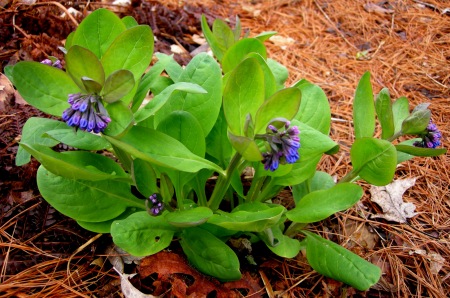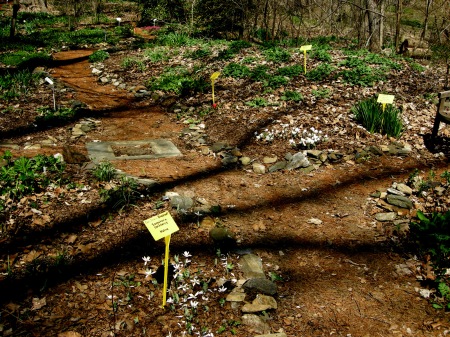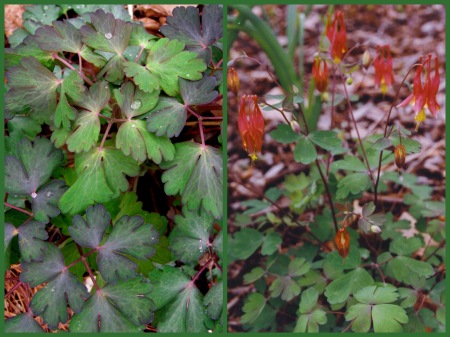Carolyn’s Shade Gardens is a retail nursery located in Bryn Mawr, PA, specializing in showy, colorful, and unusual plants for shade. The only plants that we ship are snowdrops and miniature hostas. For catalogues and announcements of events, please send your full name, location, and phone number (for back up use only) to carolyn@carolynsshadegardens.com. Click here to get to the home page of our website for catalogues and information about our nursery and to subscribe to our blog.
 PA native bloody butcher (attractive common name!), Trillium recurvatum, is just forming its buds now and will produce its beautiful flower shortly (photo on right Arrowhead Alpines).
PA native bloody butcher (attractive common name!), Trillium recurvatum, is just forming its buds now and will produce its beautiful flower shortly (photo on right Arrowhead Alpines).
All photos in this article are of plants native to Pennsylvania (PA) available at “Bulb and Native Wildflower Day” on April 9 at my nursery. Single photos and the left photo in collages show the plants in my garden today.
Jan who writes the garden blog Thanks for Today is doing something wonderful, and I want all my readers, subscribers, and customers to participate in Jan’s project. Jan has started the Gardeners’ Sustainable Living Project, which celebrates Earth Day by encouraging gardeners to get together and share the big and small things that they are doing anywhere in their lives to support sustainable living. If you read my blog, you know that this is an important topic for me.
 PA native rue-anemone, Anemonella thalictroides, is a dainty woodlander in full bloom right now.
PA native rue-anemone, Anemonella thalictroides, is a dainty woodlander in full bloom right now.
To participate in the project, all you have to do is click on the Gardeners’ Sustainable Living Project link below and leave a comment describing a few of your own sustainable living practices. If you are a garden blogger, you can write a post about your efforts, but Jan only requires a comment. If you participate by April 15, you become eligible to receive all kinds of fun prizes. I got so excited about the project, I decided to contribute a prize of my own: a snowdrop collection. For prize details, click here.
 The buds of PA native Celandine poppy, Stylophorum diphyllum, are just starting to show color, and the flowers will cover the plant for at least six weeks (photo on right Missouri Botanical Garden PlantFinder).
The buds of PA native Celandine poppy, Stylophorum diphyllum, are just starting to show color, and the flowers will cover the plant for at least six weeks (photo on right Missouri Botanical Garden PlantFinder).
While you are leaving your comment, you can read all the posts written by garden bloggers telling you what they are doing to promote sustainability. Donna at Gardens Eye View in her article on “Trust” points out that we have been entrusted with the earth and we should leave it the way we found it. She tells us about her efforts to do that. Jean at Jean’s Garden explains how she has “come to understand how my plant choices can affect ecological systems and environmental balance.”
 PA native twinleaf, Jeffersonia diphylla, is just pushing out of the ground in my garden (photo on right Missouri Botanical Gardens PlantFinder).
PA native twinleaf, Jeffersonia diphylla, is just pushing out of the ground in my garden (photo on right Missouri Botanical Gardens PlantFinder).
Pam at Pam’s English Cottage Garden was inspired by Barbara Kingsolver’s book Animal, Vegetable, Miracle: A Year of Food Life to “be more mindful of my carbon footprint by eating locally grown foods that are in season, and by supporting local farmers.” Allan at allanbecker.gardenguru describes a wide range of “respectful grass roots initiatives that influence both consumer behavior and the agendas of local officials” while promoting sustainability. You can get a lot of great ideas by reading these thoughtful articles and all the others linked there.
 I love the early spring colors of emerging PA native coral-bell leaves. Clockwise from upper left: Heuchera villosa ‘Caramel’, ‘Frosted Violet’, ‘Autumn Bride’, ‘Blackout’.
I love the early spring colors of emerging PA native coral-bell leaves. Clockwise from upper left: Heuchera villosa ‘Caramel’, ‘Frosted Violet’, ‘Autumn Bride’, ‘Blackout’.
So what am I doing to promote sustainability? For my whole gardening life, I have been organic, not using any herbicides, pesticides, or chemical fertilizers. I don’t water except to establish new plants and, by following gardening practices like grinding my leaves (seeFall Clean-up and Leaves on the Lawn) and composting, I have restored the soil to its former pristine state. I have gotten rid of almost an acre of lawn and replaced it with large areas of plants native to Pennsylvania. In Maine, I founded and continue to run a community based invasive plant removal program whose goal is to eliminate all invasive plants from the small island where we vacation.
 PA native Virginia bluebells, Mertensia virginica, is just about to come into full bloom in my garden.
PA native Virginia bluebells, Mertensia virginica, is just about to come into full bloom in my garden.
Several years ago, though, I realized that I am uniquely placed to have an even larger impact in this area through my nursery. As my customers ask me for advice and as I talk to the horticultural groups touring my display gardens, I emphasize sustainable practices and demonstrate how they work in my own gardens. Instead of being lectured to in a darkened room, these gardeners are seeing living proof that the sustainable methods I advocate have worked to create beautiful gardens.
 PA native bloodroot, Sanguinaria canadensis, is in full bloom right now. The rare double form ‘Multiplex’, pictured on the right, is much longer blooming.
PA native bloodroot, Sanguinaria canadensis, is in full bloom right now. The rare double form ‘Multiplex’, pictured on the right, is much longer blooming.
Reading Doug Tallamy’s book Bringing Nature Home: How You Can Sustain Wildlife with Native Plants was a turning point for me. I finally understood why planting native plants is not just a “good thing”, but absolutely crucial to our survival. I wrote about this in My Thanksgiving Oak Forest, and I hope you will read my article. Now I give out a synopsis of the book to the hundreds of customers who attend events at my nursery each year in hopes that they too will be inspired.
 My new yellow signs boldly demonstrate which plants are native in my woodland garden.
My new yellow signs boldly demonstrate which plants are native in my woodland garden.
As a result of my new understanding, I increased my emphasis on native plants at the nursery. Native plants appear in green print in my catalogue. I purchased new signage for the garden and the nursery so natives could have their own special yellow signs (see photo above) while non-natives have white. I am about to have my sixth annual native wildflower day on April 9 during which customers can shop for a wide assortment of almost 40 native perennials, not including the native ferns that will be offered at my fern sale.
 The foliage of PA native dwarf Jacob’s ladder, Polemonium reptans ‘Blue Pearl’, is evergreen, and the plants are covered with buds right now.
The foliage of PA native dwarf Jacob’s ladder, Polemonium reptans ‘Blue Pearl’, is evergreen, and the plants are covered with buds right now.
My two acres of display gardens demonstrate how desirable non-native plants can be incorporated into the sweeps of native plants that dominate my landscape. And I have used my blog with its 450 customer-subscribers and 26,000 views since November to promote the planting of natives (see, for example, My Thanksgiving Oak Forest, New Native Shade Perennials for 2011, and Woody Plants for Shade).
 The early leaves of PA native wild columbine, Aquilegia canadensis, are a beautiful deep blue-green and are followed by lovely flowers in April and May.
The early leaves of PA native wild columbine, Aquilegia canadensis, are a beautiful deep blue-green and are followed by lovely flowers in April and May.
So now, what do I want you to do? Please go to http://thanksfor2day.blogspot.com/2011/03/gardeners-sustainable-living-2011-win.html and leave a comment describing a few of your own sustainable practices. I know many of my customers are reading my blog because almost everyone who has visited this year has said “I love your blog”. Now you can thank me by supporting Jan’s project and mentioning in your comment that you came from Carolyn’s Shade Gardens.
Carolyn
Notes: Every word that appears in orange on my blog is a link that you can click for more information. If you want to return to my blog’s homepage to access the sidebar information (catalogues, previous articles, etc.), click here.
Nursery Happenings: My next nursery event is Bulb and Native Wildflower Day on Saturday, April 9, from 9 am to 3 pm. My next open house sale features early spring-blooming shade plants and is Saturday, April 16, from 10 am to 3 pm. For details and directions, click here.




